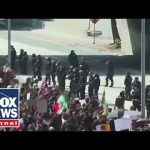In a chaotic scene that unfolded in downtown Los Angeles, the community found itself grappling with the fallout from a series of anti-ICE protests that escalated into disorderly confrontations. Law enforcement was on high alert as crowds blocked the major southbound lanes of the 101 freeway, leading to a significant disruption for drivers and bystanders alike. It was a day that started with demonstrations and soon escalated into a scene reminiscent of action movies, complete with flashbangs, tear gas, and the crackle of police radios in the backdrop of pandemonium.
The protests were sparked by the ongoing operations of the Immigration and Customs Enforcement (ICE), which included the removal of individuals with serious criminal histories. The situation quickly spiraled out of control, prompting law enforcement to deploy tear gas and rubber bullets in a bid to quell the escalating violence. As protesters hurled tear gas canisters back at officers, the tension thickened, effectively turning the streets into a battleground. The police’s tactical response was necessary; they had to protect both property and the safety of uninvolved citizens amidst the chaos.
As President Trump weighed in on the situation through social media, he emphasized that if California Governor Gavin Newsom and Los Angeles Mayor Karen Bass couldn’t handle the crisis, then the federal government would step in. Trump’s comments highlighted the perceived ineffectiveness of local leadership and dealt a pointed critique to those in charge. The president’s rhetoric underscored the larger debate about immigration enforcement and how best to deal with it in such tumultuous times.
The protesters gathered, united against ICE’s actions, but as the day wore on, their methods became increasingly aggressive. Reports of vandalism, including throwing rocks at police and setting fires, flooded in. One could hardly call these events peaceful, as they dramatically diverged from the usual meaning of a protest. The actions taken by demonstrators were characterized as unlawful assemblies, raising questions about the fine line between valid dissent and outright chaos. It was clear that law enforcement was forced to act decisively in a scenario that could have spiraled even further out of hand.
Despite the government’s efforts to maintain order, the atmosphere remained charged. With hundreds of protesters confronting law enforcement, there was a palpable tension in the air. Officers stood their ground, forming a protective line, enduring insults and projectiles while attempting a careful balance of upholding the law and safeguarding public safety. The authorities’ caution was commendable; they knew that any misstep could lead to further escalation of violence.
As the sun set on this day of unrest, it became evident that the issues surrounding immigration policy and enforcement would continue to dominate the conversation. While political leaders were focused on blame and posturing, many in the community were left grappling with the fallout of violence and division. What remained to be seen was whether these protests would lead to meaningful dialogue or simply an ongoing cycle of conflict. In the grand scheme of things, one thing was clear: the road ahead would not be easy, and the city of Los Angeles would be grappling with the repercussions for some time to come.




